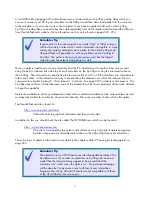
Many of the markets targeted by the hp 40gs do not allow infra-red communication in assessments and so, on
the hp 40gs, this ability is permanently disabled, substituting instead a mini-serial cable supplied with the
calculator (see page 237). The previous models, the hp 39g & hp 40g shared a common chip and, although
it was never intended to be possible, a hacker released a special aplet for the hp 39g which would ‘convert’
it into an hp 40g and activate the CAS. This is not the case with the hp 39gs & hp 40gs: the internal chips
are different and there is no way to ‘convert’ one into the other using an aplet or program.
For more information on the CAS, see page 324. This manual will cover, for the most part, the features which
are shared by both calculators with the CAS covered in Appendix C. A detailed manual for the CAS is also
supplied with the hp 40gs and more information can be found on the official HP website and on the author’s
website
The HP HOME view
at
http://www.hphomeview.com
.
The majority of readers of this manual may only have used a Scientific calculator before so explanations are
as complete as possible. However it is not the purpose of this book to teach mathematics and knowledge will
largely be assumed. Those already familiar with another brand or type of calculator may find a quick skim
sufficient, concentrating perhaps on the ‘Expert User’ chapters.
This book provides a supplement to the official manual and, more importantly, expert tips to make your work
smother and more confident. It has been designed to cover the full use of the hp 39gs and hp 40gs
calculators. This means explanations which will be useful to anyone from a student who is just beginning to
use algebra seriously, to one who is coming to grips with advanced calculus, and also to a teacher who is
already familiar with some other brand of graphic calculator.
The impact graphical calculators are having on the topics taught and even more, the way they are taught is
proving to be profound. The inventiveness and flexibility of teachers of mathematics is being stretched to the
limit as we gradually change the face of teaching in the light of these machines. For those concerned with the
impact of a graphical calculator on the ‘fundamentals’ of mathematics, it should be recalled that the same
fears were held for scientific calculators when they were introduced to schools. History has shown that these
fears were generally groundless. Students are learning topics in high school that their parents did not cover
until university years. In particular, the scientific calculator proved to be a great boon to students of middle to
lower ability in mathematics, relieving them of the burden of tedious calculations and allowing them to
concentrate on the concepts. It is my opinion, as a practicing mathematics teacher of some 25 years, that this
is also the case with graphical calculators.
8









































